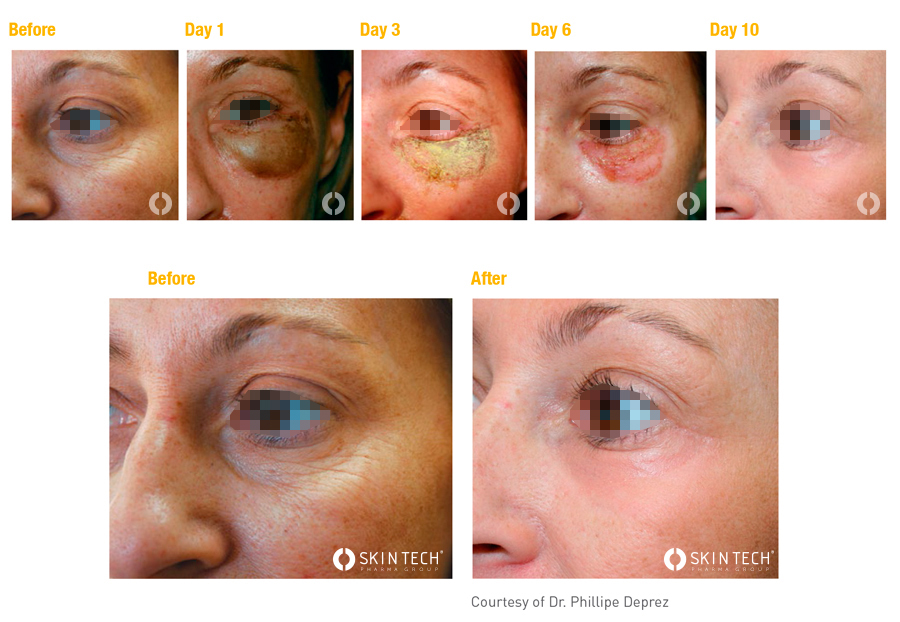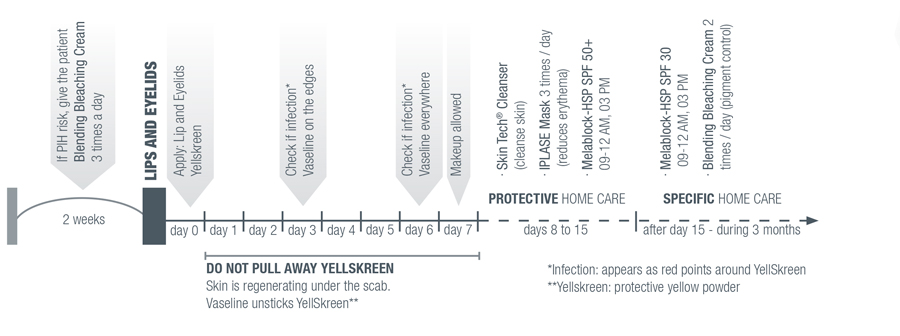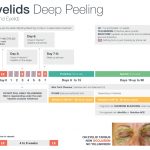Chemical Blepharoplasty
Chemical blepharoplasty of the upper and/or lower eyelids with Lip & Eyelid Formula is a relatively simple technique that does not cause bleeding and is very quick (a few minutes).
It is easy to perform with nerve blocks. Results are inadequate for treating fat pads but are excellent, if not perfect, in all resurfacing indications. The low rate of local complications and the lack of general complications make it an ideal technique to rejuvenate the eyelids when the patient does not want surgery, and the doctor is experienced in performing peels in general and in using phenol in particular. It is obvious that a chemical blepharoplasty should not be the first peel performed by a doctor who is inexperienced in this branch of medicine or cosmetic dermatology.
Pre treatment
- The patient should apply Skin Tech Blending Bleaching Cream twice a day for 2-3 weeks before peel.
- Botulinum toxin injection previous to application of the peeling solution keeps the muscles paralysed during the skin regeneration phase and allows a better and longer lasting result. Injection of botulinum toxin should take place 1 to 8 days before the peel.
- Give the patient an analgesic (paracetamol) 30 minutes before the peel.
- The skin should always be degreased with acetone, disinfected with alcohol, and degreased/disinfected with a mixture of 50% alcohol and 50% acetone before application.
- Place one drop of Vaseline-based ophthalmic ointment in the eyes (i.e., Terracortril ophtalmicum) before starting the procedure and at its end, to prevent postpeel ocular irritation.
- When treating sensitive patients, the doctor should perform nerve blocks.
- In the absence of nerve blocks, applying Lip & Eyelid triggers a strong burning sensation far approximately 15 seconds, after which the skin is numb for about 15 minutes. After 15 minutes, the patient will experience a gradual, unpleasant, warm pulsatile inflammatory sensation that generally lasts until the middle of the first night.
- Herpes prevention is necessary (valacyclovir 500 mg twice a day for 4 days before up to 4 days after the peel).
Blepharoplasty:
How to do
The choice of applicator is important. The ideal applicator is a single cotton bud: it is light, precise, and simple-all of which are good qualities when it comes to using phenol. Using a 1 ml syringe, 0.2 ml is drawn up from the 3 ml bottle of Lip & Eyelid, and the cotton bud is soaked by “injecting” 0.10-0.14 ml of the peel solution directly onto it. “The choice of applicator is important” After disinfecting the area with alcohol and carefully degreasing with acetone, Lip & Eyelid is applied carefully on the lower lids with the cotton bud. Distinct frosting occurs rapidly and marks the end of the phenol application. The tarsus of the upper eyelid is not usually treated. Applying Lip & Eyelid on the eyelid tarsus induces severe edema that is very uncomfortable for the patient and does not significantly improve results. To treat the second eyelid, 3 drops should be “injected” onto the end of the same cotton bud. The same quantity of solution is needed to treat the upper eyelids. An assistant should be present whose sole duty is to mop up any tears as soon as they appear to prevent any diluted phenol from dripping onto the face or going up into the conjunctivae by capillarity. A fresh cotton pad should be used for each tear.
STEP BY STEP
Application of Lip & Eyelid on the area around the eyes
Optimal and long lasting result
Deep reticular dermis peel against photo-aging

Combination: botulinum toxin 7 day before treatment or 14 day after treatment
Choice of peel for full face application Easy TCA Classic / Easy TCA Pain Control / Easy Phen Light
in combination with deep local peel
Recommended for aesthetic practitioners and dermatologists
An evening-out peel is necessary to prevent demarcation lines. It should be applied on the rest of the face when the Lip & Eyelid application has finished and before any occlusion is applied. Patients with a light skin type could be given four weekly sessions of Easy TCA Classic/Pain Control (to the Grenz zone) or a single session of Easy Phen Light (to the papillary dermis). It is extremely important to check for tears during a phenol peel and wipe each with a new cotton pad. Discard each cotton pad after use. The patient’s skin, dried out by the phenol, provides an ideal physiological dressing. The doctor can, however, apply a thick coat of anti-inflammatory, antioxidant, anti-erythema postpeel mask (included in the kit) immediately before applying Yellskreen powder (bismuth subgallate), The powder will stick perfectly on the postpeel mask and form a good protective barrier, allowing wet skin regeneration under the powder, which is not water soluble. After the treatment, the patient should not be allowed to sleep with the treated skin pressing against any surface (i.e., a pillow) as the treated area might stick to the surface and result in infection, scarring, prolonged erythema, or other complications.
“A bottle of Lip & Eyelid provides
enough solution for 15 treatments”
Follow-Up
See the patient on the 1st, 3rd, and 6th days following the peel to monitor progress and ensure that there is no infection. ln case of infection, give the patient antibiotics (usually orally. On the 3rd day, apply sterile white vaseline on the edge of the treated areas.
On the 6th day, apply sterile white vaseline on the entire treated area. Vaseline will help unstick the Yellskreen powder. The patient can wear makeup beginning on the 8th day, if the skin is in the right condition.
Postpeel Developments

1- EYELID OEDEME
Severe eyelid oedeme, which resolves quickly and lasts 7 days at the most, appears immediately after the solution has been applied. It peaks on the morning of the 1st and 2nd days. The oedema goes down during the day when the patient is no longer lying down. It spreads to the upper cheek on the 2nd day, the lower cheek on the 3rd day, the lower jaw on the 4th day, and on the 5th day is barely noticeable. It is not uncommon for the patient to be unable to open his or her eyelids on the morning of the 1st day. If the oedema lasts longer than 10 days, it is not normal.
2- ERYTHEMA
Erythema develops equally rapidly, a few minutes after Lip & Eyelid has been applied. It peaks during the first few weeks. The erythema takes longer to fade on lighter, more transparent skin. It always resolves, however, and is easily covered up with makeup. The bismuth subgallate powder comes away from the skin automatically with the Vaseline that prevents transepidermal water loss (TEWL) evaporation.
“The downtime is 8-10 days maximum”
3- DELAYED HEALING
The increased depth of action of the phenol sometimes translates into a persistent moist scab in the inside comer of the upper eyelid, where the phenol has macerated more intensely. Applying an antibiotic cream or ointment remedies the problem, and it should resolve before the 15th day. There are no sequelae from this slow healing. If the scab persists for more than 2 weeks, the doctor should remain alert and monitor the patient more closely.
4- RISK OF PIGMENTATION DISORDERS
Even if it is generally accepted that phenol has more of a depigmenting than a hyperpigmenting effect, the doctor must be prepared for any reactional hyperpigmentation. If the skin being treated is a very “melanin-reactive” phototype or might have a severe inflammatory reaction, the melanocytes should be “sedated” with tyrosinase inhibitors and antioxidants (Blending Bleaching Cream) before and after Lip & Eyelid, both on the areas to be treated and on the surrounding areas. The cream should be applied twice a day for 2 weeks before the peel and as soon after the peel as possible. The skin can usually tolerate Blending Bleaching Cream from the lOth day after the peel. Melanocyte “sedation” should be continued for a minimum of 6 weeks. If the peel is being performed on a skin phototype I-III and if the patient follows advice to keep out of the sun and use sun protection, there should be no post-inflammatory hyperpigmentation, but there is an increased risk of prolonged erythema on lighter skin types. The sun should be avoided completely, and effective sun protection (Melablock-HSP SPF 50+) should be used for up to 3-6 months. Exposure to UV light should be gradual thereafter. Even when the peel is applied correctly, there is still a risk of pigmentary changes, which are always reversible with Blending Bleaching Cream.
5- DEMARCATION LINE
There is clearly a risk of a demarcation line on skin with severe dyschromia or sun damage, a lot of wrinkles, freckles, keratoses, or lentigines, as the skin treated with Lip & Eyelid will look rejuvenated and stand out clearly from the surrounding damaged skin. It is especially important to combine the peel with Easy TCA or Easy Phen Light to minimize the demarcation line if the skin phototype has been properly selected.
Effectiveness
The results of a chemical blepharoplasty may be inadequate if there is a large amount of excess skin or for lower eyelid, fat pads. In these cases, surgical blepharoplasty is indicated. Applying Lip & Eyelid to the eyelids treats wrinkles and fine lines, dyschromia, keratoses, and sagging eyelids sucessfully.








